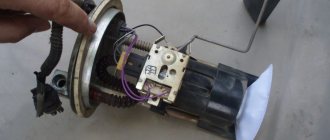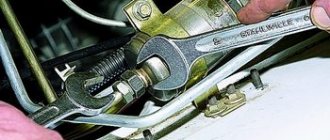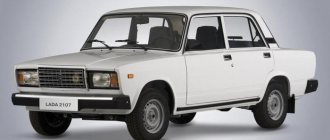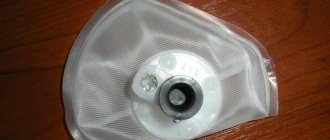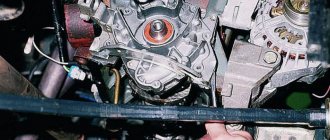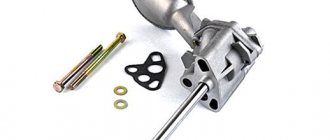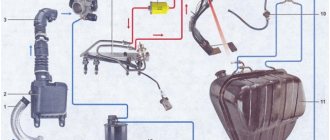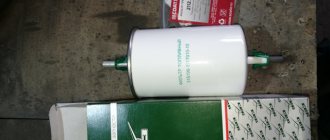Gazelle fuel pump performance
I decided to write about my replacement of the fuel pump with a more productive one from the Gazelle (everyone will laugh and say that it’s a collective farm, but this is a good replacement and tuning).
Our Fedors have a fuel pump with a capacity of up to 90 l/hour, after my pump died (at night) I installed it according to reports from the FF club from a VAZ 2110 No. 0 580 453 453
I didn’t see any difference with the original, but since I am still the owner of a gazelle car. Therefore, I know that in terms of the dimensions of these vehicles, the only differences are the same in performance and spare part number from the gazelle 120 l/h No. 0 580 454 001
and here is a photo of our dear b/n.
Good luck to everyone on the roads!
Added a photo with a cutting line.
FITS ONLY 1.8 AND 2.0; they have injectors with a capacity of 150 g/min. 1.6 has injectors with a capacity of 105 g/min.
WEBER electric fuel pumps are a high-quality certified product, excellent for working in harsh climatic and operating conditions. WEBER electric fuel pumps ensure an uninterrupted supply of fuel to the fuel line of injection engines of cars and trucks, maintaining its pressure in the operating range under any engine operating conditions.
The design of WEBER electric fuel pumps is based on the knowledge and experience of highly qualified designers and engineers of the modern automotive industry. When creating, innovative technologies from world leaders in the production of auto components are used, the most modern and high-quality materials are used.
A filter element is installed at the inlet, providing protection from the destructive effects of large particles. The working fluid, the impeller, has a unique design. The number and geometry of the blades have been optimized, which at the same rotation speed provides increased pressure and performance, while reducing vibration loads on the pump motor. The special design of the impeller ensures intensive cooling of the pump elements by the pumped fuel, increasing the service life of the windings and bearings, and minimizes the negative impact of mechanical impurities, water, ice, which are often found in domestic gasoline. The electric motors of the pumps are highly reliable and, despite the continuous exposure to the smallest solid particles, maintain pressure and performance values throughout the entire service life.
During production, special attention is paid to the quality of components and electronic systems of the product. Each part undergoes 100% control of performance and workmanship, all electrical connections are tested for reliability and resistance to corrosion.
This approach ensures maximum operational safety in conditions of constant contact with explosive and fire hazardous materials, and eliminates the possibility of sparking and premature pump failure.
Main characteristics of WEBER electric fuel pumps
Note. The parameter values presented in the table are the results of the corresponding tests:
There is often a dispute among motorists about the performance of liquid pumps. So, there are people who believe that all superchargers have the same parameters, and they output no differences, exactly seven bar. And supposedly what is given in the tables is rare nonsense.
What is a fuel pump (Gas fuel pump) of a car?
The fuel pump is an element of the fuel system necessary for supplying fuel. To operate a car engine, you need to supply gasoline from the fuel tank, which is located at the other end of the car on the Gazelle frame, directly to the engine. Fuel is pumped from the gas tank to the engine, depending on the design of the Gazelle’s fuel system, using one of two types of pumps: mechanical or electric. Carburetor engines use mechanical pumps. These motors do not require high pressure. Electric fuel pumps are used in modern vehicles with fuel injection equipment, where it is necessary to supply gasoline or diesel under high pressure.
Mechanical fuel pumps are not mounted in the Gazelle’s gas tank, but on the engine. They are simple and reliable, they are driven mechanically, from the engine (hence the name “mechanical”). Modern cars do not use a carburetor, but an injection system or injector. This system already requires high pressure. To do this, an electric fuel pump is installed in the Gazelle’s fuel system, which provides such pressure. Sometimes two fuel pumps are used at once: one of them is low pressure and the other is high pressure. The low pressure fuel pump is placed in the gas tank, and the high pressure pump is placed directly on the car engine.
The main feature of the operation of a mechanical fuel pump is as follows: it creates a vacuum in order to deliver fuel from the Gazelle tank along the line and pour it into the carburetor. In the carburetor, fuel is mixed with air and supplied to the pistons. High fuel pressure is not required for the carburetor to operate. And the main task of the fuel pump, which is located on the engine near the carburetor, is to suck gasoline from the tank and supply it to the carburetor chamber in which the float is located.
But modern cars do not use a carburetor, but an injection system or injector. This system already requires high pressure. To do this, an electric fuel pump is installed in the fuel system. With the help of such a pump, fuel is injected under high pressure through the intake manifold into the cylinders of the car. The electric pump began to operate from the vehicle network voltage (twelve volts), controlled by the main relay, the signal to which comes from the electronic control unit. This control unit controls fuel parameters, other important parameters of engine operation: exhaust, throttle valve operation, and, depending on them, regulates the supply of gasoline.
For the normal functioning of the vehicle’s fuel system, it was necessary to increase the characteristics of the fuel pump and ensure its operation at a pressure of up to six atmospheres. At the same time, the pump increased slightly in size, became more powerful and noisier. To optimize its operation, the Gazelle pump was immersed in the fuel tank. At the same time, several problems were solved. Firstly, the noise of the electric pump is not audible during operation, since it is located inside the Gazelle’s gas tank. Its operation can only be heard for a short time when the ignition is turned on. Secondly, with the pump immersed in the tank, gasoline began to perform two necessary functions: cooling the electric pump itself, as well as directly lubricating this pump with gasoline passing through it. Based on the design of the electric pump, non-returnable pumps are now gaining popularity, that is, pumps in which the bypass valve is installed directly on the pump. The system where the fuel drain line came from the fuel rail is currently becoming obsolete.
What should the pump power be?
Of course this is not true. Let's say there are two different cars. One has a 3.5 liter engine, the other has a 1.6 liter engine. In addition to the difference in volume, the engines also differ in the number of cylinders. One installation has six cylinders, the other has four. Question: Do the pumps require the same performance to supply both units with fuel fluid?
It is clear that the pressure and performance of the superchargers installed on these machines will be different. Even if the pumps are similar in appearance, their power will not be the same. That’s what it says on them: on one device – 3.8 bar at 90 liters per hour, on the other – 2.8 bar at 60 liters per hour.
There are known types of fuel pumps with even greater performance. For example, in the Bosch catalog there are devices capable of pumping 160 liters per hour or even more.
In general, it is generally accepted as follows:
- on pumping devices in which the pressure is not standardized (used for single injection) - about 1 bar;
- on pumps for electronic injection - 3-4 bar;
- on mechanical injectors - 6 bar.
There is also an opinion that for fuel backflow systems there should be a productivity of at least 2 liters per minute.
The performance of the pump depends solely on the car model. The unit simply must be able to provide the required pressure and productivity. So, if the car reaches its maximum speed (let’s say 320 km/h), it will consume about 40 liters of liquid per hundred kilometers. Using simple mathematical calculations we get 120 liters/hour. And a unit with less productivity will no longer be practical here.
Pumps and injectors from Bosch: tables
The most famous manufacturer today. Pumps from Bosch are installed on many well-known car models.
The electric fuel pump from Bosch uses a high power rating, which allows it to push fuel directly onto the injectors and into the power plant. The operation of this fuel supercharger is controlled electronically. It calculates the state of the damper, exhaust and takes into account the amount of gasoline in the fuel assembly completely in AUTO mode.
It is noteworthy that Bosch develops unique pumps for this or that brand of car. For example, for our VAZs, units with a capacity of 3 or 3.8 bar are produced. These figures are higher than those provided for by the car, however, many owners install just this option. The Bosch pump in no way affects the increase in fuel consumption, as some believe. On the contrary, fuel consumption is caused by a situation when optimal pressure is not created in the ramp, and as a result, the injectors do not function correctly - they do not spray gasoline, but simply pour it.
Thus, Bosch pumps can have different performance data. It all depends on the specific analogue. Read more in the table, which shows the types of fuel pumps by model.
| Bosch fuel pump model | System pressure max, kPa | Capacity l/h |
| 0 580 254 005 | 500 | 168 |
| 0 580 254 040 | 650 | 102 |
| 0 580 254 044 | 700 | 172 |
| 580453978 | 300 | 95 |
| 580453979 | 300 | 103 |
| 580453980 | 400 | 103 |
| 580453981 | 300 | 85 |
| 580453982 | 400 | 103 |
| 580464008 | 300 | 130 |
| 580464031 | 300 | 140 |
| 580464061 | 310 | 180 |
Bosch pumps are also installed on the popular German BMW car in Russia. Performance also varies depending on the BMW model. Basically, it is customary to divide pumps from this manufacturer for BMW into two categories.
| Productivity at rated voltage 95-135 l/h | Productivity at rated voltage 130-195 l/h |
| BOSCH 0 580 254 945 | BOSCH 0 580 464 008 |
| BOSCH 0 580 254 946 | BOSCH 0 580 464 013 |
| BOSCH 0 580 254 950 | BOSCH 0 580 464 014 |
| BOSCH 0 580 254 951 | BOSCH 0 580 464 015 |
| BOSCH 0 580 464 030 | BOSCH 0 580 464 016 |
| BOSCH 0 580 464 034 | BOSCH 0 580 464 019 |
| BOSCH 0 580 464 040 | BOSCH 0 580 464 020 |
| BOSCH 0 580 464 041 | BOSCH 0 580 464 023 |
| BOSCH 0 580 464 032 | |
| BOSCH 0 580 464 033 | |
| BOSCH 0 580 464 038 | |
| BOSCH 0 580 464 048 | |
| BOSCH 0 580 464 050 | |
| BOSCH 0 580 464 051 | |
| BOSCH 0 580 464 056 | |
| BOSCH 0 580 810 046 |
On injection engines, in addition to the pump performance, it is customary to talk about the performance of the injectors. This means their maximum possible throughput when open. In other words, over what period of time the nozzle is capable of supplying the maximum amount of fuel is this very parameter.
As a rule, most manufacturers, including Bosch, Siemens, Denso and Delphi, provide injector sizes in their catalogs according to Western standards, i.e., in f/h.
Here, for example, are the parameters of Bosch injectors according to the catalogue.
Source
Is the fuel pump dying? Just don’t buy an expensive one as a replacement!
The electric fuel pumps selected for examination are the most popular on our market. In terms of mounting dimensions and characteristics, they are suitable not only for Ladas, but also for many foreign cars - Ford, Opel, Mitsubishi, Mazda, Nissan models. Accordingly, the range offered to the buyer is so rich that making the right choice is not easy. But our examination should put everything in order.
We bought almost everything that is offered in offline stores and on the Internet. As a result, we have eight similar products sold as spare parts for Ladas or as foreign-made parts that are also suitable for Ladas. We remind you that the results we obtained relate to a specific sample of gasoline pumps and do not allow us to judge the products of a particular company as a whole.
What did you check?
The main operating parameters of an electric fuel pump are performance and pressure. We checked the pressure both at a “normal” voltage of 13.5 V and at an extremely low voltage of 6.0 V, simulating a situation with a dead battery. After all, it’s a shame to spin the crankshaft with all your might and at the same time not start the engine due to lack of pressure in the fuel rail.
We measured the current consumption of the electric motor both at maximum pressure in the line and at a constant pressure (maintained by the regulator) of 3.9 bar. We estimated the power consumption. We determined the hourly productivity of the pumps and the voltage at which the pressure regulator begins to open.
At the end of the tests, we ran the pump “dry” - to check the plausibility of the well-known horror story about the dangers of operating in such modes. One of the pumps was even forcibly braked mechanically to assess how long it would last in the “boiler” mode. The fuel pumps were powered by a Mastech HY3030E laboratory stabilized source. The working fluid was AI-95 gasoline. Pressure was measured with a verified Intercomp standard pressure gauge.
The high price of the fuel pump should not be misleading: it was sold complete with a fuel module. We tested the pump separately, and it turned out to be a solid average: it took fourth place in terms of performance, and came in third in terms of voltage when the regulator opens.
How to Test Your Car's Fuel Pump in Less Than 20 Minutes
Explanation
Your car's fuel pump is used to supply gas to the engine's fuel. Weather in injectors - gasoline or diesel fuel. Depending on the fuel system design, you may have one or more styles of pumps in different locations, mechanical and electrical models. Direct injection fuel systems can be either diesel or regular gasoline, which consists of a primary pump in the fuel tank and a secondary "high pressure" pump that is mounted and driven by the engine. A regular high pressure fuel injection system has only one main pump in the fuel tank. tank. A fuel pump test will show the performance of the pump.
What's going wrong?
As a vehicle ages, the internal parts of the fuel pump can wear out, causing a loss of pressure in the fuel rail and injectors, resulting in a rough start, hesitation and poor engine power, and when the internal part of the pump fails completely, the engine will not start.
- One or two fuel pumps depending on design
- The primary or main pump is located in the fuel tank
- May cause low power, hesitation and no starting conditions.
- Controlled by electrical relay or engine speed
- Requires external sensor to check pump performance
- Replacement requires two to three hours of work (in most cases)
- A secondary or "high pressure pump" is installed on the engine
What is the price?
Most people don't have a fuel pump testing kit, but have no fear, auto parts stores will provide you with one free in most cases. If you suspect the fuel pump is going weak in your car and you take the car to the store to have a test done, you can count on pay between $90.00 and $150.00 US.
let's start
Start with the vehicle on level ground in a park with emergency brake kit, engine off (no smoking or open flame) This test is for in-tank fuel pumps only.
- Pressure Port: Some vehicles are designed with a convenient pressure port on the engine fuel rail (remove the cover) to attach the sensor to other designs you will need an adapter from the test kit that can be attached to the fuel filter or fuel pressure line directed to the engine fuel rail.
- Remove the fuel pressure sensor from the kit. Most sensors have a quick connect that will allow you to use several different adapters for different manufacturers. The kit should be labeled with them, but if not look for a hose connector or fitting that will work for your vehicle.
- When installing the pressure gauge (engine not running), a small amount of fuel may be present, so don't be alarmed, have a shop towel ready.
- Without starting the engine, turn the ignition key to the on position. The gauge should jump to between 45 psi and 58 psi (DPI) of the direct port injection system, throttle body injection (TBI) should be between 13 and 17 psi in most cases as the system primes. If no pressure is present, recheck the hose or adapter connection to avoid false negatives, turn the ignition on again to recheck. Still no pressure? There is a suspected malfunction of the fuel pump, fuel pump relay or fuse.
- Now start the engine so we can test the pump's performance. While the engine is running, fuel pressure should drop approximately 5 psi. static primary pressure (DPI), then press the throttle, fuel system pressure should jump about 5 psi. this means the fuel pump and pressure regulator are working correctly. If the fuel pressure in the system does not respond, check the supply line vacuum regulator and, if everything is ok, the fuel pressure regulator is faulty (if and
What happened?
The performance range was from 67.1 to 146.7 l/h - more than double!
The lowest performance was found in an expensive pump costing 3,250 rubles. Let us remind you that we bought the cheapest one for only 900 rubles.
Details are in the final table.
Of all the results obtained, we consider the main ones to be the pressure regulator opening voltage, as well as the pump efficiency - the ratio of performance to power consumption. We recalculated these values into ratings on a five-point scale: more is better. Their arithmetic average allows us to judge the technical perfection of the pump.
The best were the Italian ERA Fuel pump and the Chinese Kortex KPF. It is curious that both were sold as “foreign” ones: the first for Mitsubishi, the second for Mazda.
But the worst in all respects was... Bosch.
The actual characteristics of the tested pumps are not proportional to the price tags, so in conclusion we calculated the price/quality ratio, also bringing it to a five-point rating system.
Surprisingly, the leader was not a frankly cheap pump, but... the same Italian EPA. Absolute victory!
When to change the fuel pump?
The reason for replacing the fuel pump, in addition to its complete failure, is usually a changed behavior of the car. Let us list the most characteristic signs of a pump “dying”:
- partial loss of power;
- inadequate reaction to gas;
- Unstable engine operation at minimum idle speed;
- change in the tone of the engine;
- noise in the fuel tank;
- Uncertain engine start.
In all these cases, as a rule, mechanical wear of the electric fuel pump parts or burning of its contacts is to blame. Sometimes the fuel inlet filter is simply dirty. It can be washed, or better yet, buy a new one and replace it.
OUR COMMENT
The pressure developed by the pump when the line is closed indicates the perfection of its design. The higher the pressure, the better the fuel pump. The pump is designed with a technological reserve that ensures its uninterrupted operation regardless of fluctuations in supply voltage, temperature and gasoline parameters.
The pressure regulator maintains the fuel pressure in the power system at a safe level, for which all elements are designed - hoses, tubes, injectors. Without it, a pump operating with a technological reserve will exceed the permissible pressure, which can lead to system failure.
The opening voltage of the pressure regulator (3.9 bar) indicates the threshold from which normal operation of the power system begins. The lower it is, the better.
The parameters taken at a supply voltage of 6 V indicate that the electric fuel pump can start the engine when the battery is extremely low. The higher the pressure, the better the fuel atomization at the injector outlet.
Source
Fuel pressure regulators - function, symptoms and testing
All fuel injection engines have fuel pressure regulators to maintain a controlled high pressure level.
So, fuel pressure regulators must maintain constant pressure; to ensure that all components of the fuel injection system work properly.
And, if the pressure goes outside this range, the car will not work or will not work efficiently.
So, fuel pressure regulators maintain fuel pressure between 25 and 60 pounds of pressure; depending on the car and manufacturer. There is a main fuel line from the fuel tank to the fuel rail.
Checking engine fuel pressure
Also the fuel return line from the fuel pressure regulator. This return line is located below all injectors.
Fuel pressure regulators use a combination of a diaphragm and a spring inside a housing; with a vacuum source on the top side of the diaphragm.
Therefore, it should counteract the spring pressure when high demand dictates the need for higher fuel pressure.
So, a sudden drop in vacuum will affect the fuel pressure. This occurs because the fuel injectors open wide suddenly. It takes a few seconds for the fuel injectors to sense the pressure being created. At these moments, the fuel pressure regulator temporarily turns off the fuel return line. As a result, it helps to increase the fuel pressure for a few moments.
The computer uses sensors to determine:
- Air temperature
- Air density
- Load capacity
- Throttle position
- Engine temperature
Sensors
Therefore, using this information, the computer decides the strategy that will result in the best performance of the engine.
Fuel pressure regulators usually fail in one of two ways:
When it doesn't hold pressure, it delivers too little fuel to the engine, resulting in a lean mixture.
When the fuel pressure regulator gets stuck and creates more pressure than it should; this will cause the injectors to deliver too much fuel; causing a rich mixture (high pressure) condition.
Malfunction of the fuel pressure regulator Symptoms:
- Spark plugs are blackened
- dipstick smells like gasoline
- Gasoline drips from the exhaust pipe
- Engine mounts
- Gasoline in vacuum hose
- Deceleration problems Poor fuel consumption
Vacuum and Leak Testing
The easiest way to check fuel pressure regulators is to use a fuel pressure gauge.
Fuel pressure tester
So, this test checks the operation of the fuel pressure regulator; to make sure it changes line pressure in response to changes in engine vacuum. In addition, this is necessary to maintain proper operating pressure behind the injectors and; to compensate for changes in engine load.
With the engine running, disconnect the vacuum hose from the pressure regulator. Typically, fuel system pressure should increase by 8 to 10 psi. Inch with the line disconnected. No changes will indicate a faulty pressure regulator or a leaking or clogged vacuum line.
Also, with the vacuum hose disconnected from the regulator, check the inside of the hose for moisture, which may indicate fuel is being sucked into the hose. There shouldn't be any there. The diaphragm inside the regulator leaks if there is fuel in the hose.
This will result in a drop in fuel pressure; and allow fuel to be sucked into the intake manifold, disrupting the air-fuel mixture. So, if the diaphragm is leaking, replace the regulator.
Conclusion
So, always replace your fuel filter at the vehicle manufacturer's recommended intervals. Also, a clogged filter will cause a drop in fuel pressure and damage the fuel pump. Thus, it is more cost-effective to maintain the fuel filter regularly.
Please share DannysEnginePortal News
Fuel pumps GAZ
Electric fuel pump module 9P2 960. 023
It is a submersible electric fuel pump module with a fuel level indicator sensor assembly. Designed to supply fuel from a gas tank and create operating pressure in the power system of a gasoline engine, as well as to ensure control of the fuel level in the tank.
Used on GAZelle cars.
Electric fuel pump module 9P2 960. 022
It is a submersible type electric fuel pump module with a fuel indicator sensor assembly and a built-in fuel pressure regulator. Designed to supply fuel from a gas tank and create operating pressure in the power system of a gasoline engine, as well as to ensure control of the fuel level in the tank.
Used in Volga 21105 cars with a Chrysler engine, maximum fuel consumption is 50 l/h at a pressure in the system with a drainless fuel line of 400±34 kPa.
Electric fuel pump module 9P2.960. 006
It is a submersible electric fuel pump module with a fuel level indicator sensor assembly. Designed to supply fuel from a gas tank and create operating pressure in the power system of a gasoline engine, as well as to ensure control of the fuel level in the tank.
Used on promising Volga cars.
Electric fuel pump module 9P2.960. 031
It is a submersible type electric fuel pump module with a fuel indicator sensor assembly and a built-in fuel pressure regulator. Designed to supply fuel from a gas tank and create operating pressure in the power system of a gasoline engine, as well as to ensure control of the fuel level in the tank.
It is used in GAZelle cars with a Chrysler engine, maximum fuel consumption is 50 l/h at a pressure in the system with a drainless fuel line of 400±34 kPa.
Source
Fuel pump pressure gazelle 405 injector
Repair and service of cars, engines and automatic transmissions
Adjustments of parts of the fuel system of the ZMZ-405 engine
The power supply system (fuel system) ZMZ-405 of the GAZ-3302 Gazelle Business, GAZ-2752 Sable cars is designed to supply fuel and air to the engine cylinders.
Fig. 10 – Schematic diagram of the power supply and control system ZMZ-405 for GAZ-3302 Gazelle Business, GAZ-2752 Sobol
The fuel supply system includes a fuel tank, fuel pump, fuel filter, fuel lines, fuel rail with pressure regulator and injectors. The fuel tank is steel, with a capacity of 64 liters. The filler neck is located on the left side of the car and is connected to the tank with a rubber hose. A check valve is installed inside the neck to prevent fuel from leaking out when the car turns over. The neck is hermetically sealed with a stopper. The above-fuel space of the tank is connected to the atmosphere through a double-acting valve. The valve allows air into the tank as fuel is consumed and releases excess pressure from the tank as the ambient temperature rises. The valve is fixed to the neck of the tank and connected by a plastic tube to a ventilation fitting, which is installed in the upper part of the tank on a thread. Fuel module ZMZ-405 for GAZ-3302 Gazelle Business, GAZ-2752 Sable cars - installed in the fuel tank and combined with a fuel level indicator sensor. Fuel drawn from the fuel tank passes through a strainer installed on the fuel pump intake pipe. The fuel pump (gasoline pump) of the internal combustion engine ZMZ-405 of the GAZ-3302 Gazelle Business, GAZ-2752 Sable is electric, submersible type, installed in the fuel module. Connected to the fuel module cover with electrical wires and a corrugated hose. The fuel pump is turned on by command from the electronic engine control unit and develops a pressure of at least 3 bar. From the pump, fuel under pressure is supplied through a fuel line through a fine filter into the fuel rail. Fuel filter ZMZ-405 for GAZ-3302 Gazelle Business, GAZ-2752 Sable – non-separable with a metal body, mounted on the car frame near the right front wheel. The fuel rail is designed to supply fuel to the injectors. The ramp is made of aluminum alloy and is attached with two bolts to the intake manifold. A brass fitting is installed at the front end of the ramp for connection to the fuel supply line.
Fig. 11 - Engine fuel rail with ZMZ-405 injectors for GAZ-3302 Gazelle Business, GAZ-2752 Sable 1 - protective cap of the threaded fitting; 2 – fuel rail; 3 – connection fitting for the fuel supply line; 4 – fuel supply line holder; 5 – nozzle; 6 – injector o-ring For accurate dosing of injected fuel, it is necessary to maintain fuel pressure at the injector inlet fittings. For this purpose, a fuel pressure regulator is installed at the rear end of the ramp. The pressure regulator is a fuel valve connected to a spring-loaded diaphragm. The valve is closed under the action of the spring. The diaphragm divides the valve cavity into two isolated chambers - fuel and air.
The air chamber is connected to the intake pipeline, and the fuel chamber is connected directly to the ramp cavity.
The vacuum in the receiver, overcoming the resistance of the spring, tends to retract the diaphragm during engine operation and thereby open the valve. On the other hand, fuel presses on the diaphragm, also trying to compress the spring. As a result, the valve opens and part of the fuel is released through the drain pipe back into the tank. If the throttle valve is closed, the vacuum in the receiver is maximum and the valve is fully open. When you press the gas pedal, the throttle valve opens and the vacuum in the receiver decreases. The diaphragm, under the action of a spring, closes the valve and the fuel pressure increases. The injector of the ZMZ-405 engine is an electromagnetic valve that allows fuel to pass through when voltage is applied to its winding. After the tension is removed, the valve closes under the action of the spring. At the lower end of the injector there is a nozzle through which, when the injector valve opens, fuel is injected into the intake manifold. The connections of the injector with the ramp and the inlet pipeline are sealed with rubber rings. The air supply system includes an air
